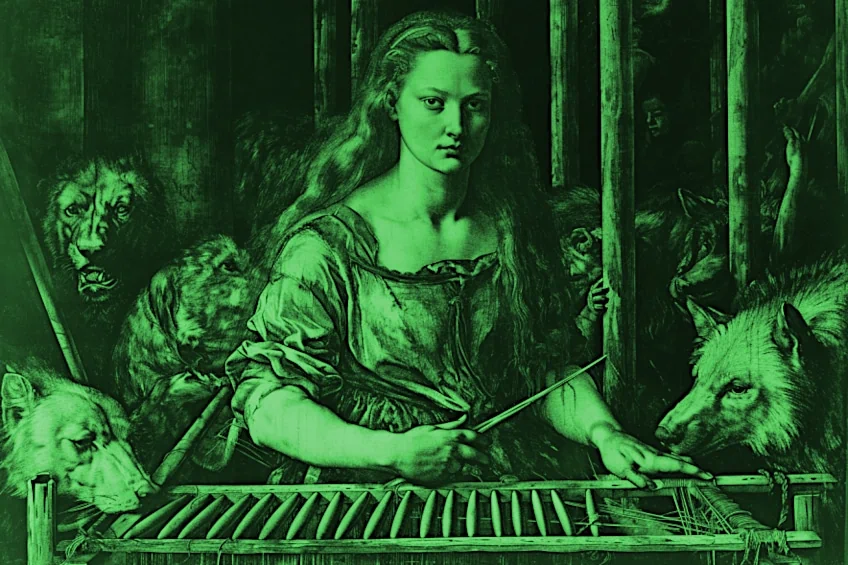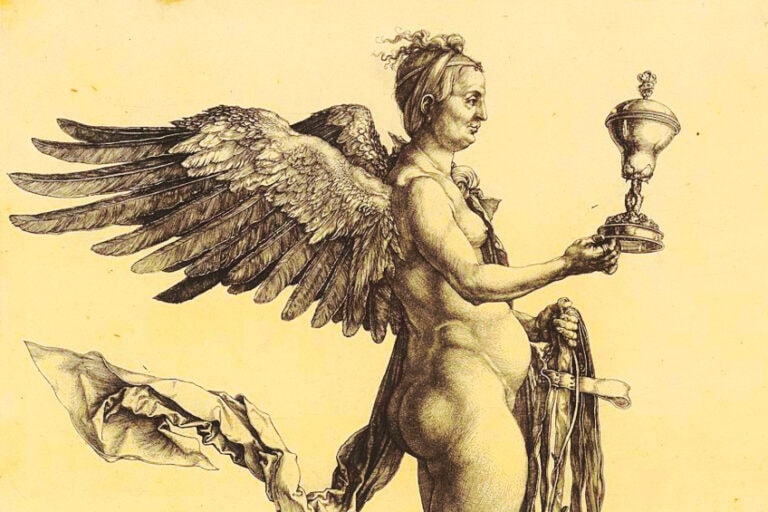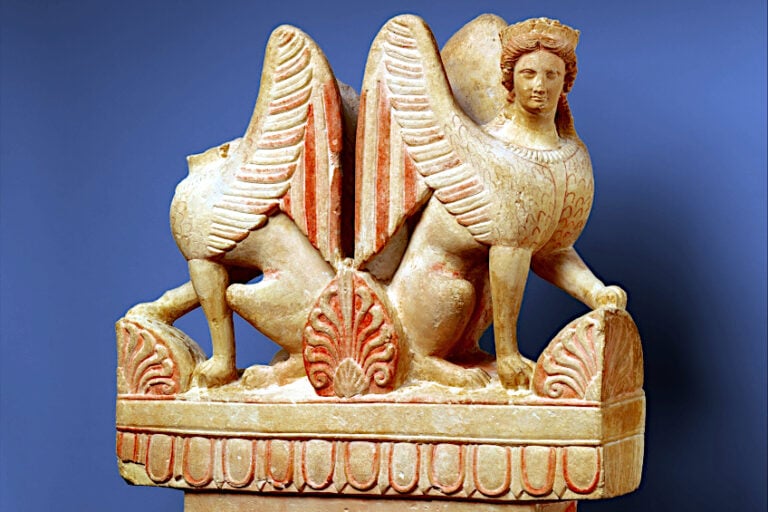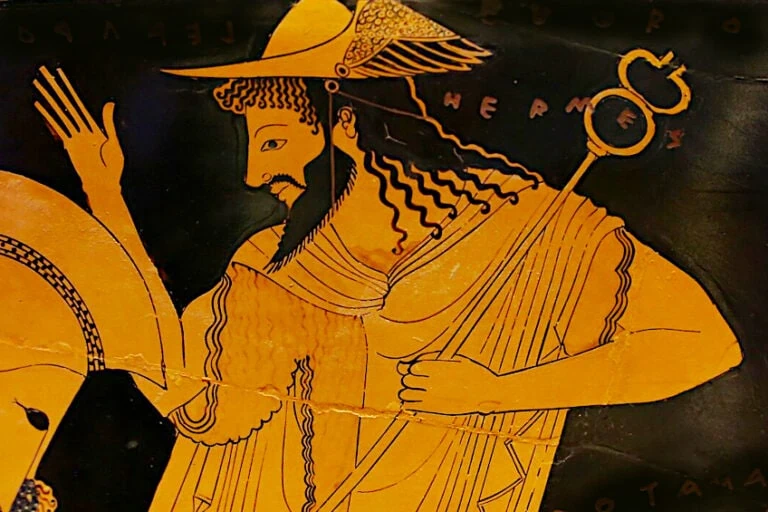Greek Goddess Circe – The Sorceress Who Made Beasts of Men
What was Circe the goddess of in Greek mythology? Circe was a famous enchantress, who along with Hecate was a Greek goddess of magic. She was also known to have an extensive knowledge of herbs and potions which she used these to tame wolves and lions. Circe also had a magic staff that she used to transform men into pigs. In art, this wand served as a prominent Goddess Circe symbol along with her loom, at which Homer describes her weaving while singing. The most well-known stories of Circe’s Greek mythology can be found in the Odyssey. Circe changed most of the hero’s crew into swine, before Hermes helped him to outwit her. At this point she became a gracious host and even advised Odysseus on how to return home.
Contents
The Mythology of the Greek Goddess Circe
| Name | Circe |
| Gender | Female |
| Symbols | Staff and wand |
| Personality | Lonely, deceitful, sexual, greedy, but helpful once outwitted |
| Domains | Transformative magic |
| Parents | Helios and Perse |
| Spouse | Odysseus and Telemachus |
| Children | Telegonus, Cassiphone, Rhomos, Ardeas, Latinus, Agrius, Auson, Casiphones, and Anteias |
The dangerous Greek goddess Circe was frequently mistaken for her gentle counterpart Calypso, because they both delayed the homecoming of Odysseus by keeping him under their spell on their respective islands. Circe is described by Homer as a terrifying deity with unusually beautiful hair and human speech.
The Greek goddess Circe was also seen as the predatory feminine archetype.
This behavior made her famous as a magician as well as a sort of sexually liberated lady from the perspective of people of a subsequent generation. From the Renaissance period to the present, she has been regularly represented as such in all art forms.
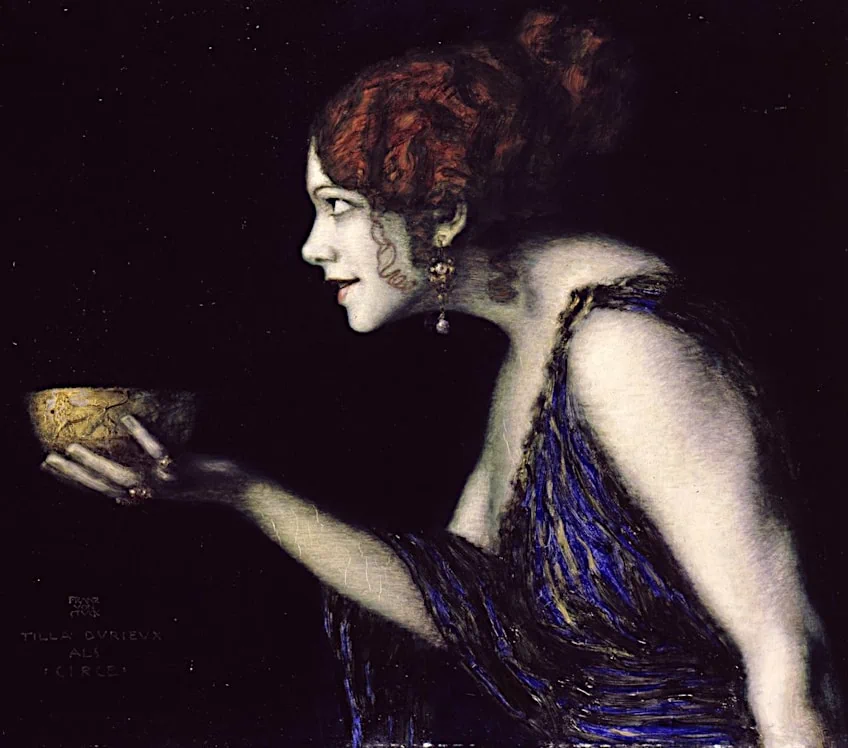 Tilla Durieux as Circe by Franz Stuck (c. 1913); Franz Stuck, Public domain, via Wikimedia Commons
Tilla Durieux as Circe by Franz Stuck (c. 1913); Franz Stuck, Public domain, via Wikimedia Commons
Family and Background
The Greek goddess Circe is believed to be the offspring of Helios and Perse in most accounts of her mythology. Perse is an ocean nymph and Helios is the god of the sun in ancient Greek mythology.
In other versions of Circe’s Greek mythology, she is regarded as the daughter of the goddess of sorcery, Hecate.
Circe had two male siblings. One brother was known as Aeetes, and he was in charge of the golden fleece, the magical object that Jason and the Argonauts went in search of.
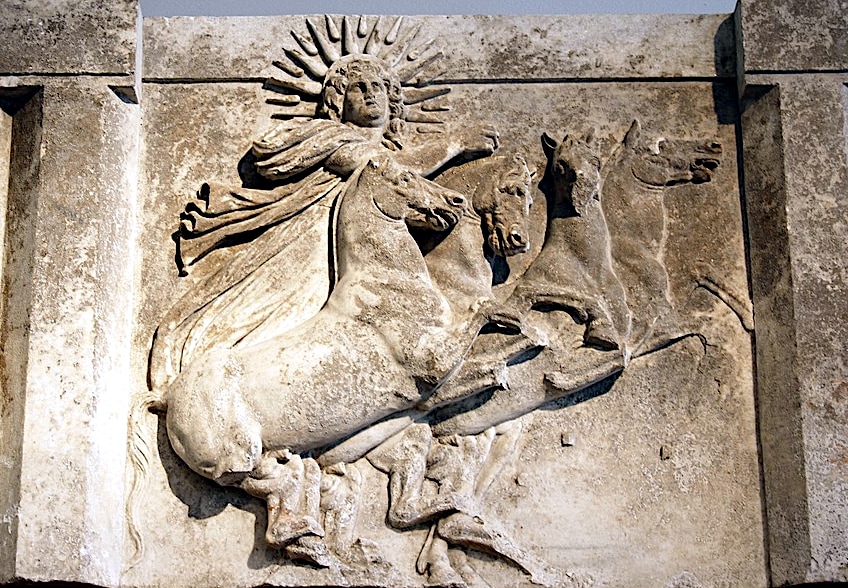 Relief from the temple of Athena at Ilion-Troy depicting Helios in his solar chariot (300-280 BCE); © José Luiz Bernardes Ribeiro
Relief from the temple of Athena at Ilion-Troy depicting Helios in his solar chariot (300-280 BCE); © José Luiz Bernardes Ribeiro
Perses was her other brother. Pasiphae was the Greek goddess Circe’s only sister as well as the queen of the Greek island of Crete, and King Minos’ wife. It was also stated that Circe gave birth to the Minotaur, a monster that was half bull, and half man with a cow’s horns and head and a man’s body.
Some myths held that Circe was exiled to the island of Aeaea by Helios, as penance for murdering her husband the prince of Colchis.
In some stories she had two children by Odysseus named Telegonus and Casiphones. Later authors added more sons who were generally associated with the foundation myths of various Roman cities. Their names were Rhomos, Ardeas, Latinus, Agrius, Auson, Casiphones, and Anteias.
Role in Mythology
What is Circe the goddess of? Witches have a long and illustrious history dating back to ancient Greece. Circe is often regarded as the first witch in Greek mythology and was introduced to us by Homer in his epic adventure narrative The Odyssey. The Greek goddess
Circe was one of the most perilous immortals that an individual could meet.
She was infamous for attracting males to her island and never letting them depart. When men came to the island, they were lured by her beautiful palace, her enchanting singing, and finally, driven insane by their insatiable need to touch her, Circe caught them by surprise and used magic to turn them into pigs.
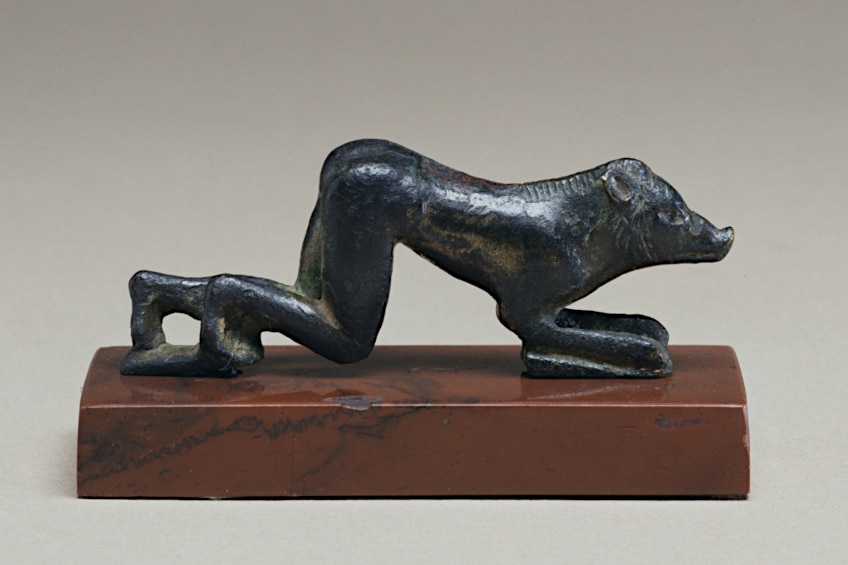 Bronze statuette of one of Odysseus’ men transformed into a pig (5th Century BCE); Walters Art Museum, Public domain, via Wikimedia Commons
Bronze statuette of one of Odysseus’ men transformed into a pig (5th Century BCE); Walters Art Museum, Public domain, via Wikimedia Commons
Personality and Attributes
Circe is a formidable sorceress with extraordinary magical talents. She has the knowledge and ability to turn humans into animals as well as the other way around. Her magical items and potions are enticing, and she often puts individuals under her spell.
Circe is a sensuous and intriguing character. She tames wild beasts while depriving men of their humanity.
But she is also a gracious and captivating host. Her experience with Odysseus is a great example: she falls deeply in love with him and like Calypso, encourages him to stay with her on her island for ever, instead of returning home to his kingdom.
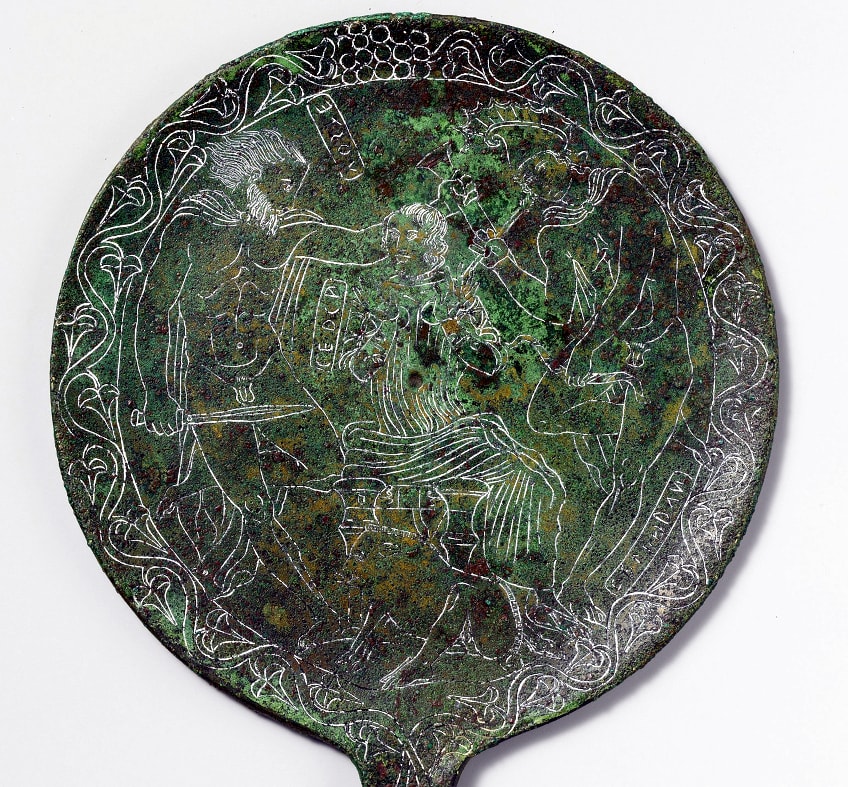 Bronze Etruscan mirror with a depiction of Circe and Odysseus on the back (c 350-300 BCE); Metropolitan Museum of Art, CC0, via Wikimedia Commons
Bronze Etruscan mirror with a depiction of Circe and Odysseus on the back (c 350-300 BCE); Metropolitan Museum of Art, CC0, via Wikimedia Commons
Her attraction is both dangerous and fascinating and the Greek goddess Circe is often associated with mysticism and wisdom. She is well-versed in plants, potions, and magic. She is seen as a knowledgeable individual who comprehends the complexities of the universe and mortal aspirations.
Symbols
Circe, the Greek mythological sorceress, is connected with a number of symbols. Circe is sometimes represented with a magic staff or wand in her hand, symbolizing her mastery of sorcery and enchantments. Circe is sometimes shown holding a cup or chalice, symbolizing her function as a brewer and administrator of elixirs and potions. Circe, the sun god’s daughter, is frequently shown wearing a crown or tiara, representing her divine heritage and rank.
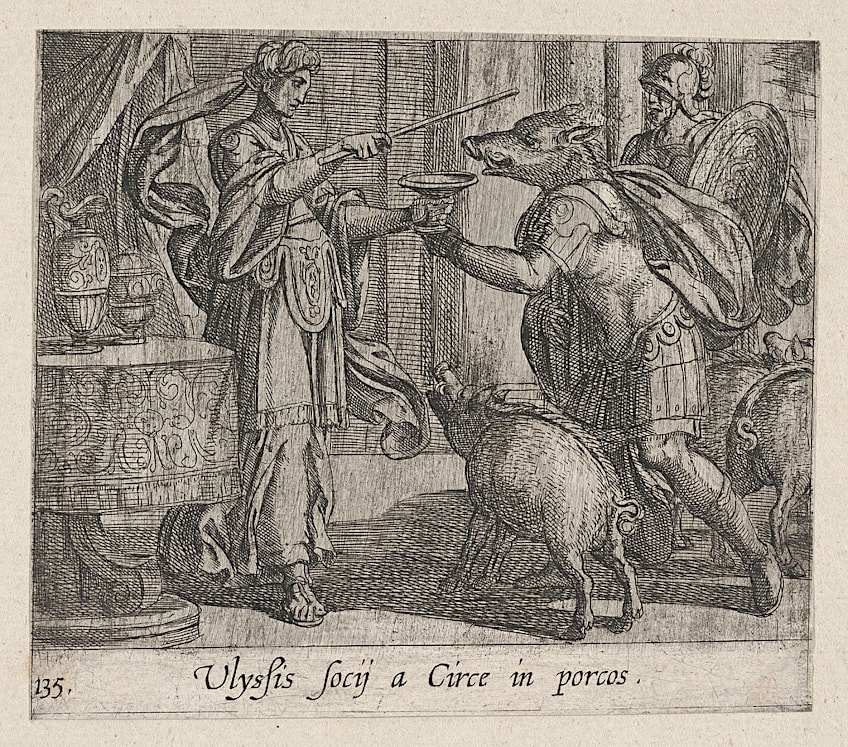 Circe Transforming Odysseus’ Men into Swine by Antonio Tempesta (1606); Antonio Tempesta, CC0, via Wikimedia Commons
Circe Transforming Odysseus’ Men into Swine by Antonio Tempesta (1606); Antonio Tempesta, CC0, via Wikimedia Commons
Circe is linked to animals, namely her capacity to change humans into animals. Pigs are frequently connected with Circe, as she famously transformed Odysseus’ soldiers into pigs in the epic story. Circe’s understanding of plants and potions is an important aspect of her personality. She may be seen in certain artistic portrayals surrounded by or holding various plants and flowers linked with her magical skills.
Circe’s island, Aeaea, is frequently depicted metaphorically in relation to her. It represents her dominion and acts as the scene for much of her mythology.
Circe’s Mythology
In this chapter we will explore Circe’s Greek mythology. Although she does not feature in many stories, there is a common thread of magical transformation that runs throughout, from changing Odysseus’ men into swine to poisoning the spring where the nymph Scylla bathed, resulting in the terrifying sea monster that preyed on sailors.
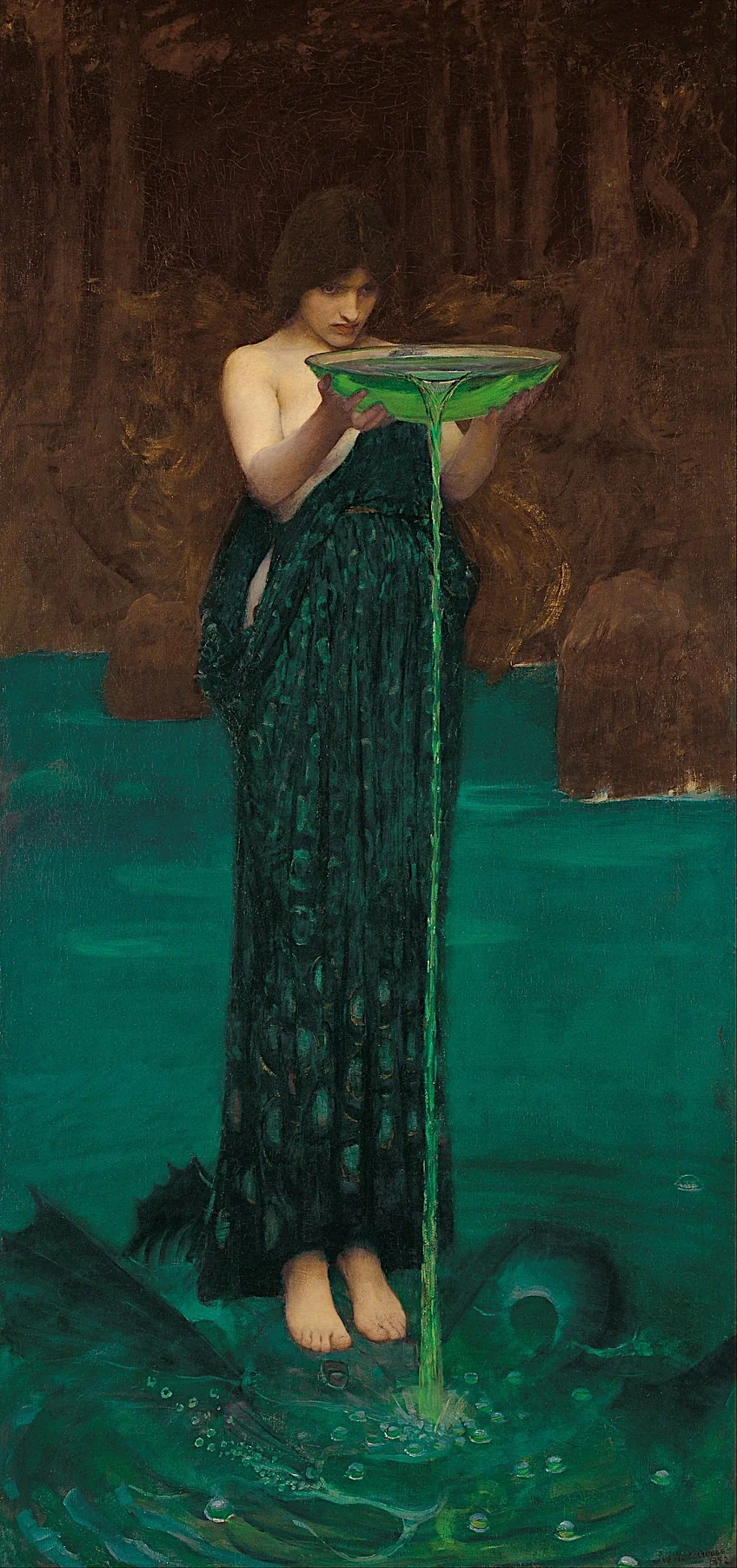 Circe Individiosa by J. W. Waterhouse (1892); Art Gallery of South Australia, Public domain, via Wikimedia Commons
Circe Individiosa by J. W. Waterhouse (1892); Art Gallery of South Australia, Public domain, via Wikimedia Commons
Circe and Odysseus
He and his soldiers sailed on over the wine-colored sea till they came upon an island. They slid their sailing vessel into a quiet little harbor and slept for a few days. The next morning, Odysseus suggested they look around the island and find out who lived there. His men grew terrified at his suggestion. They recalled the terrifying Cyclops who had imprisoned them in his cave and eaten some of their fellow sailors.
Odysseus divided his soldiers into two separate groups so that if one got into difficulties, the other could come to their aid. He was the head of one group, and Eurylochus led the other.
They pulled straws to choose who would go first and investigate the woods, and because Eurylochus picked the short straw, he and his soldiers had to go first. The men arrived at a clearing after a couple of hours of wandering. They noticed a little cottage surrounded by wild predators such as leopards, wolves, and lions that all appeared to be tame. Eurylochus was suddenly approached by a leopard. He feared he was going to die, but rather than eating him, the leopard brushed up against him, purring like a cat. The house’s window was open, and a woman was singing inside.
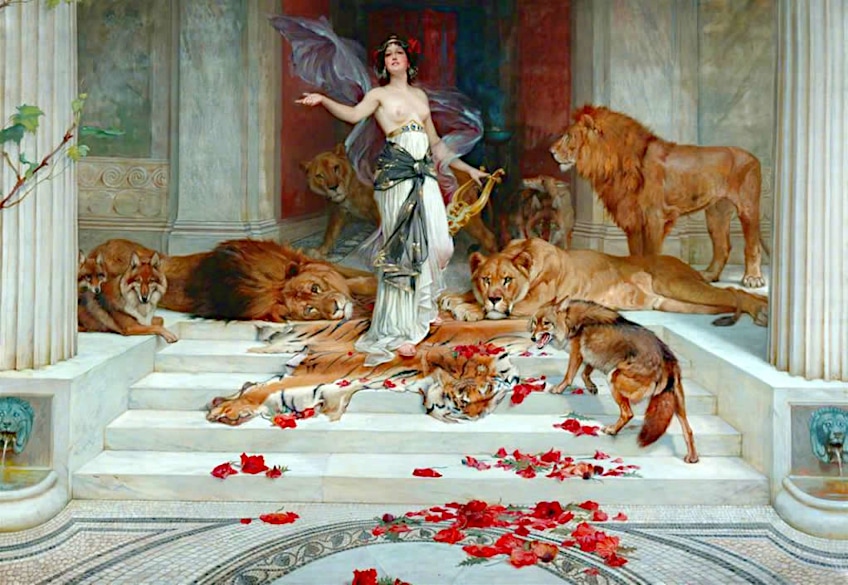 Circe by Wright Barker (1889); Wright Barker (British Painter, 1864-1941), Public domain, via Wikimedia Commons
Circe by Wright Barker (1889); Wright Barker (British Painter, 1864-1941), Public domain, via Wikimedia Commons
Her voice was mysterious but incredibly beautiful, and the men were lured to the home because they all wanted to see if the woman was as amazing as her voice. They wandered passed the ferocious-looking creatures, who were actually fairly mild. Inside, they were met by a tall and gorgeous woman with braided black hair – she did indeed appear extremely attractive. Circe asked the men to sit at her table and sip some of her soup, and they gladly accepted. “When I pulled the short straw, I regretted my bad luck”, Eurylochus muttered as they consumed the soup. “Perhaps our hostess isn’t so bad after all, eh men?”.
They didn’t realize that, despite her beauty, Circe was a witch. She’d put a magical concoction into their soup, and after they’d eaten it, she tapped the table with her magical staff and shouted, “Now you pigs, go to the pigsty where you belong.”
The men were taken aback and glanced up. “Lady – did you just call us pigs?”, Eurylochus inquired. Circe only chuckled in response, for Eurylochus’ nose had begun to turn pink, and his hands were turning into hairy trotters. In fact, all of his troops were rapidly transforming into pigs. They attempted to scream out and grieve, but all they were able to do was snort and screech. “Pigs should stay in the pig sty, not in my kitchen”, said Circe, “away with you!”, and they trotted off to their new home.
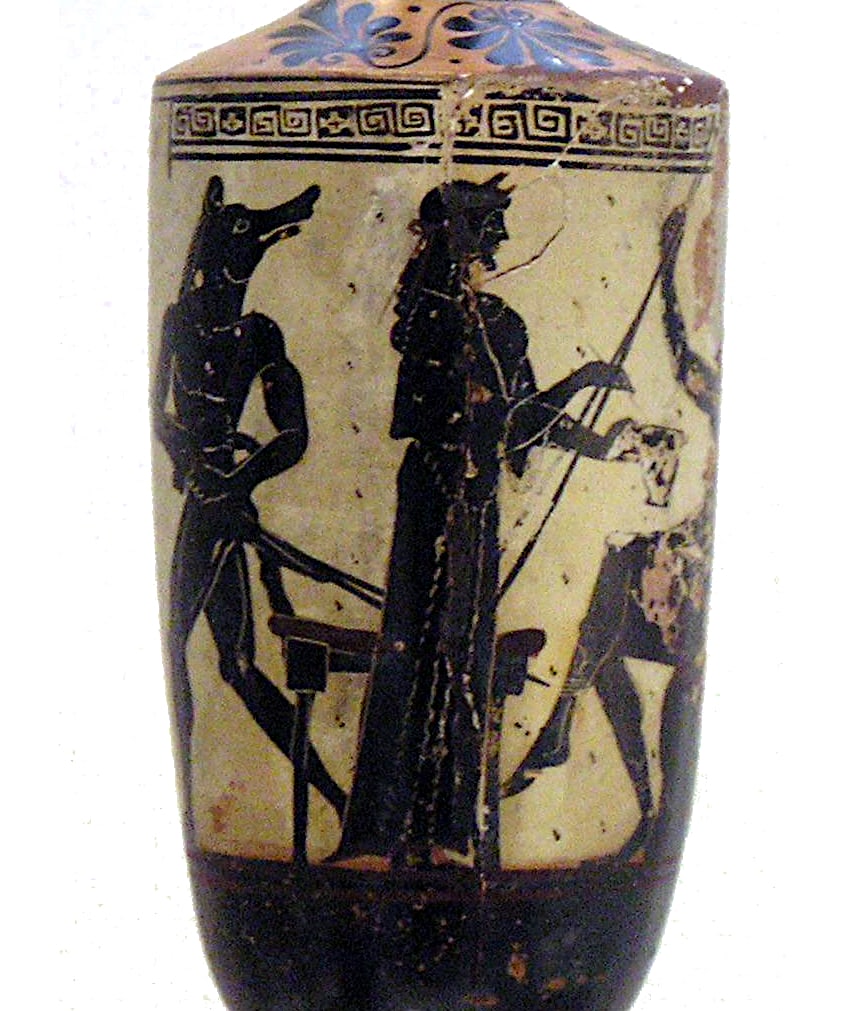 White-ground lekythos with a depiction of Circe, a man turned into swine and Odysseus seated by the Athena painter (c. 490-480 BCE); Marsyas, CC BY-SA 2.5, via Wikimedia Commons
White-ground lekythos with a depiction of Circe, a man turned into swine and Odysseus seated by the Athena painter (c. 490-480 BCE); Marsyas, CC BY-SA 2.5, via Wikimedia Commons
Odysseus became concerned when the men failed to come back to the ship and determined to go in search of them. He went out over the island toward the plume of smoke he’d seen from the cabin and encountered a young man. The young man asked the stranger what he was doing there. Odysseus replied that he was searching for his men. The young man replied that they were most likely Circe’s guests and that they would not be found in the house but in the pigsty instead. He warned that she was a witch, and if he dared try to step into her house, he too would be turned into a swine.
The youth pulled a little plant from his bag and presented it to Odysseus. It had a black stem and a milky white bloom. “Eat this”, he instructed, “it will protect you from all magic tricks and potions.”
Moly was the name of this plant. It is perilous for humans to pluck since only gods can safely pull it out of the earth. Odysseus realized this was Hermes, the gods’ messenger. After eating the herb Odysseus arrived at the mansion in the woods where he was met by the attractive witch, who invited him to sit and eat a little of her soup. She poured some magic potion into the soup as it was boiling, intending to transform Odysseus into a swine like the rest. Odysseus drank it all, and then she pulled out her magic staff and banged the table. Instead of turning into a pig, Odysseus sprang to his feet, took his sword, and charged at Circe. She screamed in terror and fell to his feet, pleading for compassion. She asserted that it was only because she lived alone that she pulled such tricks and beckoned Odysseus closer.
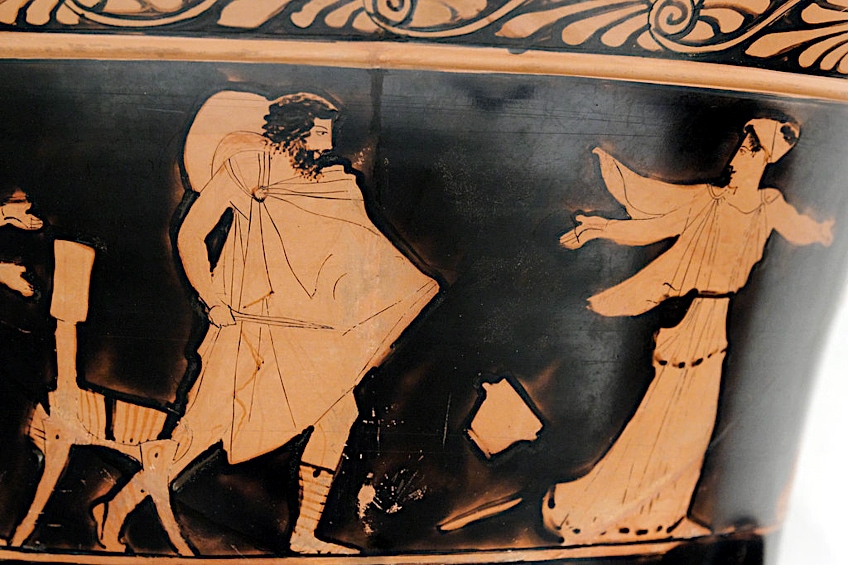 Attic red-figure calyx-krater with a depiction of Odysseus threatening Circe (c. 440 BCE); Metropolitan Museum of Art, CC BY 2.5, via Wikimedia Commons
Attic red-figure calyx-krater with a depiction of Odysseus threatening Circe (c. 440 BCE); Metropolitan Museum of Art, CC BY 2.5, via Wikimedia Commons
Odysseus let the lovely witch kiss him, but he kept an eye on her to make sure she didn’t try any more of her tricks. She summoned her maids and instructed them to put on a bath for her guest. After bathing and resting, Odysseus saw that they were cooking a lovely feast for him. Circe asked him why he appeared so grief-stricken and told him to eat, but he replied that as a leader it was impossible for him to enjoy the meal while his men had to suffer the fate of staying outside in the form of pigs. The Greek goddess Circe walked outside and applied a magical medicine on the animals. Then she waved her magic staff, and they started to transform back into men, only younger and more attractive than before.
Circe After the Odyssey
In sources beyond Homer the Greek goddess Circe and Odysseus had three sons, Latinus, whose daughter married Aeneas, Agrius, and Telegonus, who ruled over the Tyrsenoi, or Etruscans.
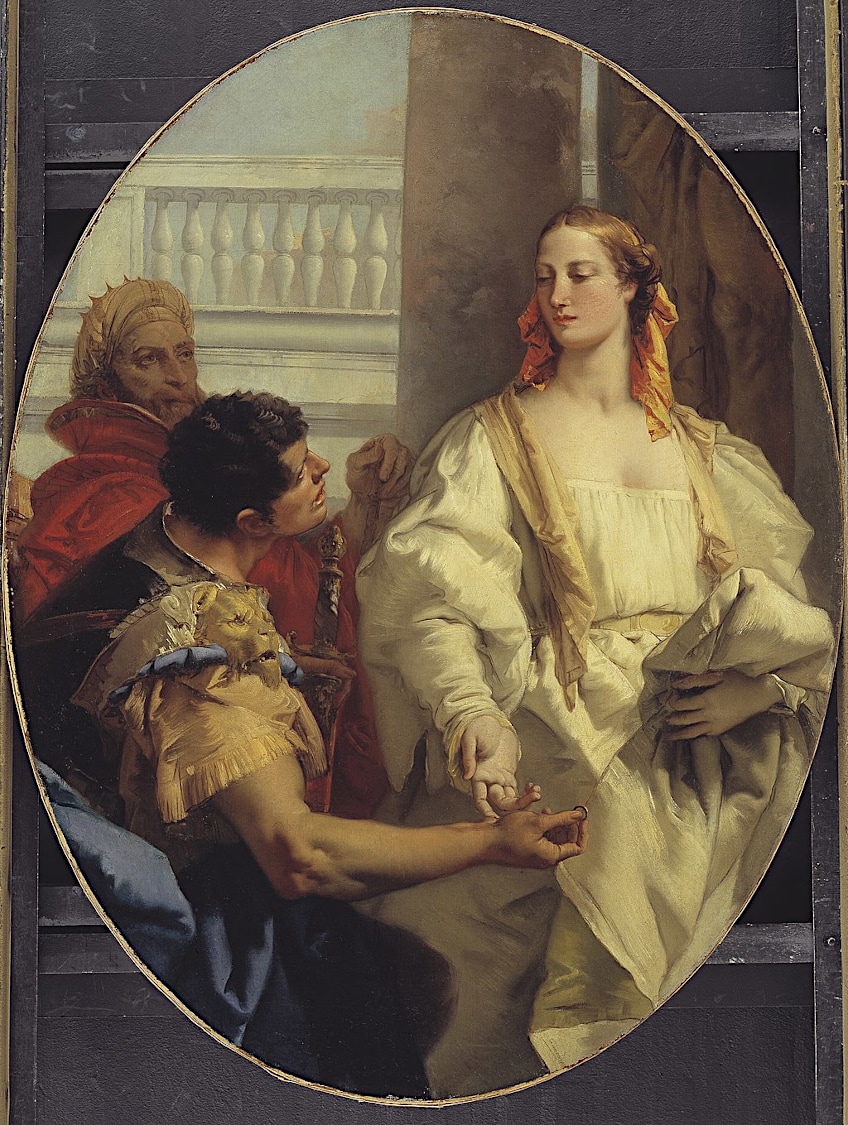 Latinus Offering his Daughter Lavinia to Aeneas in Matrimony by Giovanni Battista Tiepolo (1753-1754); Giovanni Battista Tiepolo, Public domain, via Wikimedia Commons
Latinus Offering his Daughter Lavinia to Aeneas in Matrimony by Giovanni Battista Tiepolo (1753-1754); Giovanni Battista Tiepolo, Public domain, via Wikimedia Commons
The Telegony, a now-lost epic, tells the latter history of the Telegonus. Circe told her son of his father’s absence and handed him a poisoned weapon when he went out to locate Odysseus. Odysseus was engaged in the battle with the Brygi in Thesprotia when Telegonus appeared in Ithaca.
Odysseus arrived to protect his country as Telegonus started destroying the island. Telegonus murdered his father inadvertently using the sword Circe provided him.
Telegonus then sent his father’s corpse to Aeaea, along with Odysseus’ and Penelope’s son, Telemachus. Circe immortalized the other three after burying Odysseus. Circe married Telemachus, while Telegonus married Penelope at Athena’s suggestion. Circe employed magical plants to bring Odysseus back to life after he was murdered by Telegonus, according to an alternate narrative described in Lycophron’s 3rd-century BCE poem Alexandra. Odysseus then married Telemachus to Circe’s daughter Cassiphone.
Other Myths
Three ancient plays concerning the Greek goddess Circe have been lost: those of the tragedian Aeschylus and the comedic dramatists Ephippus of Athens and Anaxilas from the 4th century BC. The first recounted Odysseus’ meeting with Circe. Odysseus’ half-transformed animal-men may have comprised the chorus instead of the typical Satyrs, according to vase paintings from the time. Anaxilas’ fragments also describe the metamorphosis, and one of the characters laments the inability to scratch his face now that he has been turned into a pig.
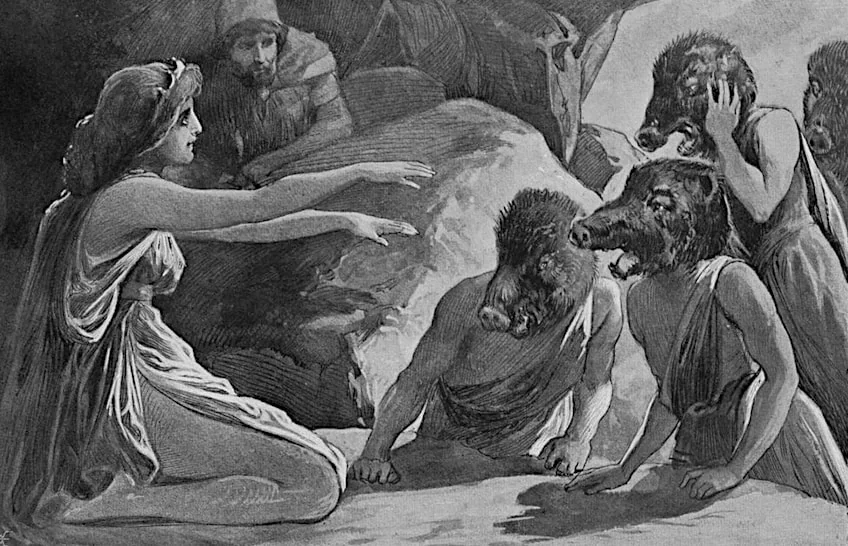 Circe Lifts the Curse from Odysseus’ Men by Geiger Richárd (1900); Geiger Richárd (1870-1945), Public domain, via Wikimedia Commons
Circe Lifts the Curse from Odysseus’ Men by Geiger Richárd (1900); Geiger Richárd (1870-1945), Public domain, via Wikimedia Commons
Plutarch took up the issue in a spirited discussion, which was thereafter imitated by numerous others. The Gryllus incident, in which Circe permits Odysseus to interrogate a fellow Greek turned into a pig, is included in his first-century Moralia.
After his counterpart informs Odysseus that his current existence is preferable to the human, they start a philosophical debate in which every human value is called into question, and creatures are shown to be wiser and more virtuous.
Circe After the Greek Era
Circe and her tales are mentioned throughout Roman literature, including the works of Virgil, Ovid, and Apuleius. Circe’s encounter with Odysseus is recounted in Ovid’s Metamorphoses, for instance. Greek tales and figures were frequently included in the works of these Roman authors, who adapted and reinterpreted them for their own audience. Circe appeared in a number of works during the medieval and Renaissance periods.
Circe is represented as a witch in Dante Alighieri’s Inferno, and she is discovered in Hell’s eighth circle. She also appears in The Canterbury Tales by Geoffrey Chaucer.
Throughout history, the Greek goddess Circe has remained a prominent topic in visual art. Scenes from her legends were represented in paintings, sculptures, and other creative works, with a focus on her interaction with Odysseus and the transformation of his men into swine. Circe was depicted in paintings by artists such as Dosso Dossi and John William Waterhouse.
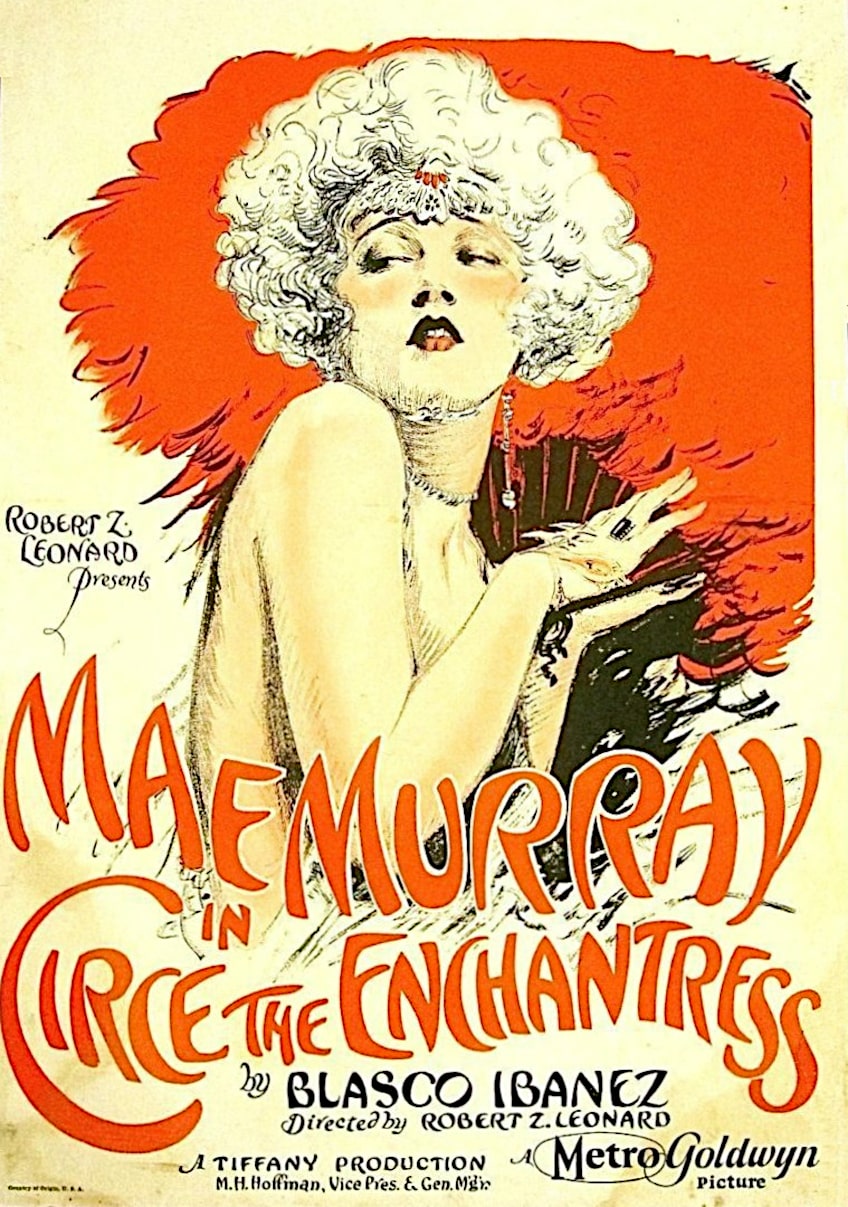 Advertising poster for the film Circe, the Enchantress (1924); Tiffany Pictures, Public domain, via Wikimedia Commons
Advertising poster for the film Circe, the Enchantress (1924); Tiffany Pictures, Public domain, via Wikimedia Commons
The Greek goddess Circe has recently enjoyed a comeback in popularity. Madeline Miller’s novel Circe was published in 2018, rewriting Circe’s narrative and diving further into her character. Circe’s position and significance have received increased attention as a result of this work and other modern adaptations.
Circe and Science and Literature
Ancient literary stories captivated scientists so much that they began to look for scientific answers inside them. Circaea, also known as Enchanter’s Nightshades, was given the name after the Greek goddess Circe because of legends about her ability to utilize potions against her adversaries. Circe, according to 16th-century botanists, utilized them for these purposes.
While undertaking research in his specialty, enzymologist William Jencks attempted to explain the tale of Circe. His research culminated in an enzyme reaction known as “The Circe Effect”.
Circe was also quite famous among scientists. Carl Linnaeus, a botanist, named a species of Venus clams after the Greek goddess, and Jean Chacornac, a French astronomer, named a dark main-belt asteroid (34 Circe) after her. Circe’s popularity did not go away with the demise of old religions. During the Middle Ages, she became a significant symbol in Giovanni Boccaccio’s moral fables.
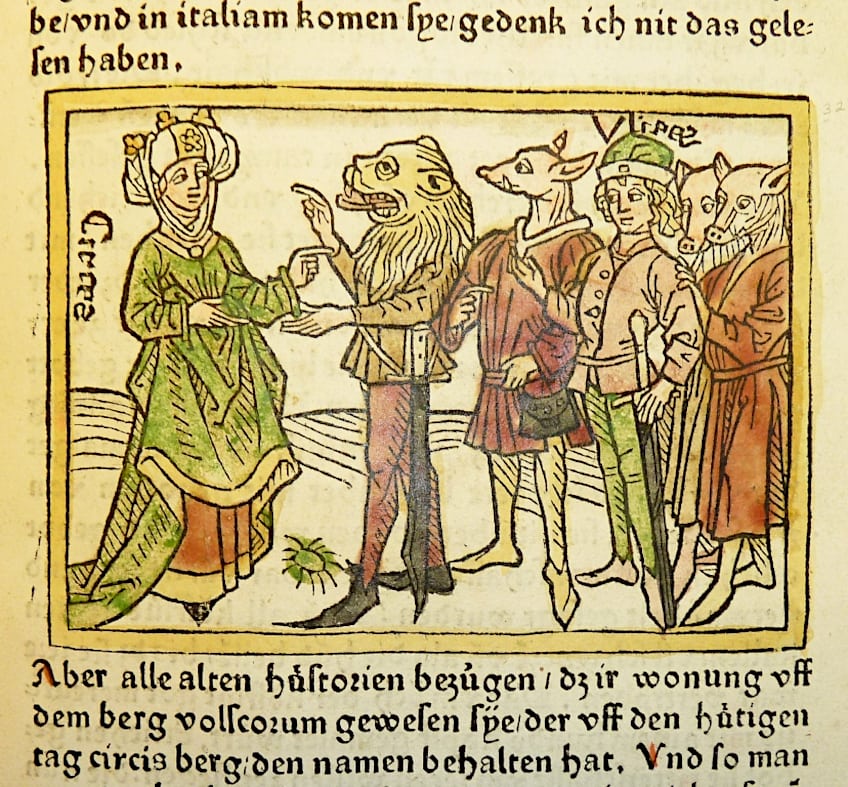 Woodcut illustration of Circe and Odysseus from Heinrich Steinhöwel’s translation of Giovanni Boccaccio’s De mulierbis claris (1473); kladcat, CC BY 2.0, via Wikimedia Commons
Woodcut illustration of Circe and Odysseus from Heinrich Steinhöwel’s translation of Giovanni Boccaccio’s De mulierbis claris (1473); kladcat, CC BY 2.0, via Wikimedia Commons
According to medical historians, the metamorphosis of the men into pigs was not meant to be taken literally but rather alludes to anticholinergic intoxication with the herb Datura stramonium. Hallucinations, amnesia, and delusions are among the symptoms. The definition of “moly” suits the snowdrop, a blossom that includes galantamine, a long-lasting anticholinesterase that can consequently counteract anticholinergics delivered into the human body after it has been taken.
Sexual Politics
With the Age of Renaissance, there was a rethinking of what it was that transformed mankind if it wasn’t merely magic. In Classical times, gluttony had overcome their self-control, according to Socrates. But it was unchastity, according to the famous emblematist Andrea Alciato. In poems supposedly about the enchantress, two American writers also examined feminine psychology. The first verse of Leigh Gordon Giltner’s Circe from her book The Path of Dreams (1900) tells the customary narrative of men turned into pigs by her spell. Then, in a second verse, a sensual description of an unknown lady is presented before closing with the line: “Circe’s charms change men into pigs”.
This is a depiction of Circe, not a passive victim of masculine delusions, but rather a woman aware of her own innate sexual powers.
Representations in Art
Scenes from the Odyssey, including the Greek goddess Circe’s tale, are frequent on Greek ceramics. Circe is surrounded by changed sailors in the two most prevalent depictions, and Odysseus threatens the witch with his sword. The animals in the former are not necessarily boars but also include the dog, ram, and lion on the 6th-century BCE Boston kylix. Often, the transition is just partial, with the head and maybe a growing tail remaining human. Circe is nearly often portrayed stirring the potion with her wand in these scenes, despite the fact that the action as related by Homer sees her using the wand solely to bewitch the mariners after they had refreshed themselves. The Berlin amphora, on which the sitting Greek goddess Circe wields a stick towards a half-transformed male, is a notable exception.
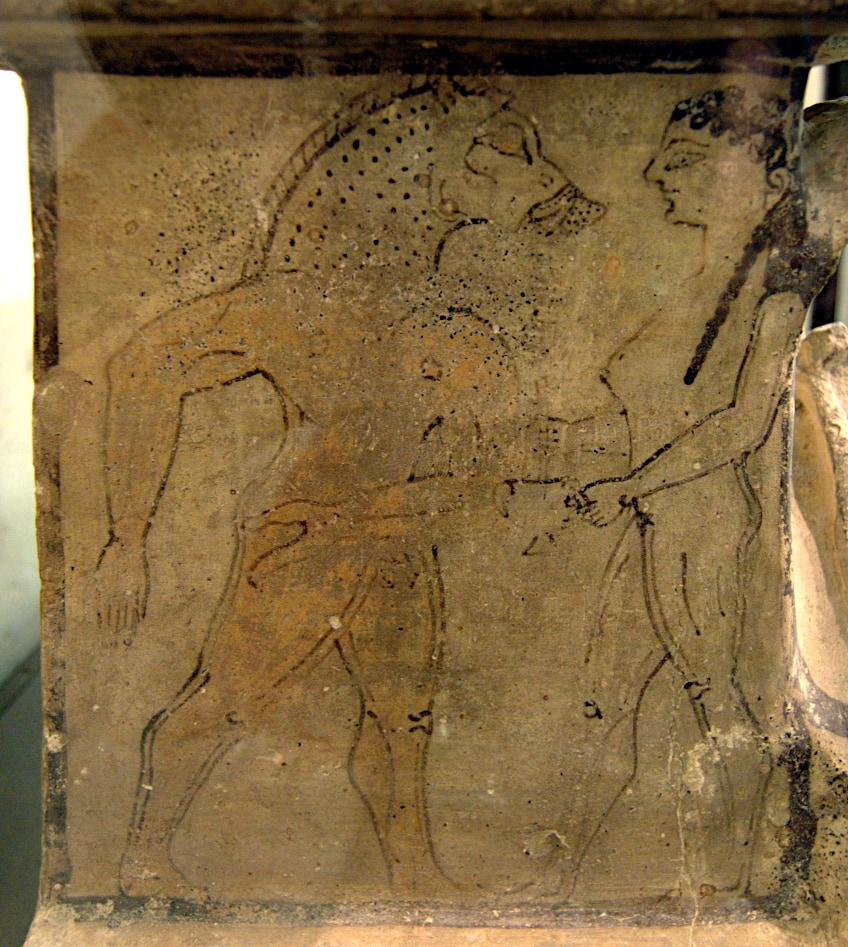 Right-hand side of a small altar (arula) showing Circe holding a cup facing a man transformed into a pig (6th Century BCE); Louvre Museum, Public domain, via Wikimedia Commons
Right-hand side of a small altar (arula) showing Circe holding a cup facing a man transformed into a pig (6th Century BCE); Louvre Museum, Public domain, via Wikimedia Commons
As Homer relates it, Odysseus confronts the witch with a drawn blade in the second scene. Yet, he is occasionally represented holding spears, as in the Athens lekythos, whereas Homer tells that he was carrying a bow draped over his shoulder. Circe is often represented in flight in this period, and on the Erlangen lekythos, she can be observed dumping the wand and bowl behind her. Two rather rudimentary wine bowls feature a Homeric detail of Circe’s handloom, where men entering her castle might hear her singing softly as she worked.
Other vase paintings from the same period show that Odysseus’ half-transformed animal-men, rather than the customary satyrs, composed the chorus.
It should be a theme of such plays because wine consumption was frequently crucial to their plots. Later writers would view the story in the same way that Socrates did, by highlighting the perils of inebriation. Other artifacts reflecting the narrative include the chest of Cypselus recorded in Pausanias’ travels.
That completes our look at the Greek goddess Circe. What is Circe the divinity of? As a Greek goddess of magic, she was often regarded alongside Hecate and Medea as one of antiquity’s most dangerous witches. She was renowned for her ability to use her potions and elixirs to turn humans into various types of animals. She lived on the island of Aeaea, where she would lure sailors in and turn them into swine. People have sought answers through magical arts and witchcraft since the dawn of time. As a result, Circe became one of the most intriguing women in Greek mythology. Circe’s personality contain all of the essential themes associated with dangerous seduction and witchcraft, making her a patron of witches and femme fatales.
Frequently Asked Questions
What Is Circe the Goddess Of?
In Greek mythology, the Greek goddess Circe is regarded as the goddess of magic and sorcery. She is most known for her role in the story of Odysseus, wherein she turned his men into pigs. As the Greek goddess of magic, she was known to have a thorough knowledge of herbs and magic plants. She was known as a goddess that one would not like to get on the bad side of, lest you find yourself turned into an animal!
What Are Circe’s Goddess Symbols?
The Greek goddess Circe’s wand represents her power to accomplish magic. It allows her to aim her spells and transformations on those that she wishes to inflict by acting as a conduit for her power. Circe’s wand is adorned with beautiful features that symbolize her celestial ancestry. For example, it is embellished with sun-related symbols or patterns, commemorating her father, the sun deity Helios. Circe’s wand helps her to convert humans into animals. She can perform these magical transformations by waving her magic instrument or touching her people with it.

I am deeply passionate about history and am constantly fascinated by the rich and complex stories of the past. As the editor-in-chief of learning-history.com, I have the opportunity to share this passion with a wide audience through the creation and distribution of engaging and informative content about historical events, persons, and cultures. Whether it’s through writing articles and blog posts or creating videos or podcasts, I strive to bring the past to life in a way that is both accurate and enjoyable. My expertise in history, combined with my strong writing and communication skills, allows me to effectively communicate complex historical concepts and make them accessible and interesting to a wide range of readers. I am truly grateful for the opportunity to share my love of history with others through my work on learning-history.com.

